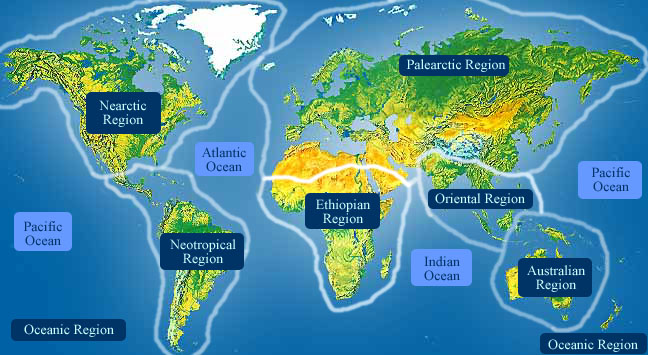Heloderma suspectumGila Monster
Geographic Range
The Gila monster ranges from the extreme southwestern Utah, southern Nevada, and adjacent San Bernadino County, California, southeastrward through west and south Arizona and southwestern New Mexico. It ranges south into Mexico through Sonora to northwestern Sinaloa. It ranges from sea level to 1,500 meters in altitude. (Ernst, 1992)
Habitat
The Gila monster can be found in arid areas. These areas usually contain scattered cacti, shrubs, mesquite, and grasses. Rocky slopes, arroyos, and canyon bottoms (mainly those with streams) support populations in Arizona. (Ernst, 1992)
- Terrestrial Biomes
- desert or dune
Physical Description
This is one of only two venomous lizard species in the world (the other is the Mexican beaded lizard, Heloderma horridum). Gila monsters are large and stout lizards with a short fat tail (maximum length of 56 centimeters). Their scales are beaded yellow, pink, and black. The broad head, chin, and neck are black, as well as the legs and feet. The black eyes have a round pupil. The ear opening is a narrow oblique or ovoid slit. The limbs of the lizard are stout and have heavy claws. (Ernst, 1992)
Reproduction
Mating, which is usually in May, begins with the male tongue-flicking to seek a females's scent, while rubbing his cloaca on the ground. When a male locates a female, he lies by her and rubs his chin on her back and neck while holding her with his hindlegs. If a female objects to the male, she will try to bite him while crawling out from underneath. If receptive, she raises her tail. The male then moves his tail under hers, bringing their vents into contact. Copulation lasts from 30 minutes to an hour. The female lays her eggs (1-12) in an underground cavity, normally in July or August. Incubation lasts on average about ten months, and the young to hatch and emerge the following May. The process (fertilization through emergence) lasts about a year. (Ernst, 1992)
Lifespan/Longevity
-
- Average lifespan
Status: captivity - 8.3 years
- Max Planck Institute for Demographic Research
- Average lifespan
-
- Average lifespan
Status: captivity - 20.0 years
- Max Planck Institute for Demographic Research
- Average lifespan
Behavior
Few data are available on the population structure and dynamics of the Gila monster because the organisms are extremely difficult to sex. The Gila monster is a diurnal forager. It is referred to as being a "docile reptile." (Ernst, 1992) ( http://www.Pharmacy.Arizona.EDU/centers/poison_center/critters/reptiles/gila monster.|)
Food Habits
The Gila monster's diet consists of a variety of objects: small mammals (young rabbits, mice and squirrels), birds, lizards, and eggs (of birds, lizards, snakes, turtles, and tortoises). The Gila monster has the capability to consume large amounts of food at one time (young can consume 50% of their body weight at a single feeding, adults can consume 35%). This is advantageous in an envirnoment in which finding prey at regular intervals may be difficult. Prey are rarely envenomated, which indicates that venom is used mainly for defense. Prey are detected by olfaction (the sense of smell). The Gila monster, like most snakes, uses its tongue for olfaction. (Ernst, 1992) (Bogert, 1956)
Economic Importance for Humans: Positive
The Gila monster has little economic importance to humans. There is a small market for the hemipenis, which is used as an aphrodisiac. A small "pet" market for the species has also arisen. It is illegal, however, for the Gila monster to be captured or held in the states where it exists. The reptiles can be found in many zoos. (Bogert, 1956) ( http://www.Pharmacy.Arizona.EDU/centers/poison_center/critters/reptiles/gila monster)
Conservation Status
The lizard is often killed because it is poisonous. The Gila monster is legally protected in all states in which they are found. (Ernst, 1992) (Bogert, 1956)
-
- IUCN Red List
-
Near Threatened
More information
-
- IUCN Red List
-
Near Threatened
More information
-
- US Federal List
- No special status
Other Comments
The Gila monster lacks the ability to jump, contrary to popular myth (Ernst, 1992)
Contributors
Matthew D. Stewart (author), University of Michigan-Ann Arbor.
Glossary
- Nearctic
-
living in the Nearctic biogeographic province, the northern part of the New World. This includes Greenland, the Canadian Arctic islands, and all of the North American as far south as the highlands of central Mexico.

- desert or dunes
-
in deserts low (less than 30 cm per year) and unpredictable rainfall results in landscapes dominated by plants and animals adapted to aridity. Vegetation is typically sparse, though spectacular blooms may occur following rain. Deserts can be cold or warm and daily temperates typically fluctuate. In dune areas vegetation is also sparse and conditions are dry. This is because sand does not hold water well so little is available to plants. In dunes near seas and oceans this is compounded by the influence of salt in the air and soil. Salt limits the ability of plants to take up water through their roots.
- native range
-
the area in which the animal is naturally found, the region in which it is endemic.
References
Ernst, C.H. 1992. Venomous Reptiles of North America. Smithsonian Institution Press, Washington.
Bogert, C.M. 1956. The Gila monster and its Allies. Volume 109. American Museum of Natural History, New York.
http://www.Pharmacy.Arizona.EDU/centers/apdic/gilamonster.shtml



